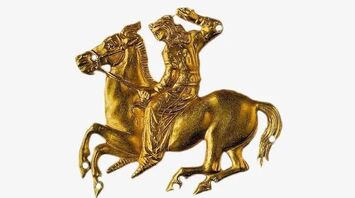Scythian on Horseback: A 2,400-Year-Old Gold Sculpture of a Warrior Heading Into Battle

The Scythians, known for their intricate gilded artworks, were a nomadic group hailing from the Black Sea region, which is now part of Turkey. This particular artifact, a gold plaque created around 400 to 350 B.C., depicts a Scythian warrior riding a horse.
The Scythians constituted a culturally connected but diverse group of nomads who inhabited regions spanning southern Siberia, Central Asia, and the northern Black Sea from about 800 to 300 B.C. These fearsome warriors left behind little written literature; most of our knowledge comes from outsiders. As the Greek historian Herodotus noted in the fifth century B.C., "None who attacks them can escape, and none can catch them if they desire not to be found."
Artifacts, particularly their prolific goldworks, are crucial for understanding Scythian history. In addition to their skills as goldsmiths, the Scythians were adept at breeding domesticated horses. A 2017 study revealed that these Iron Age nomads effectively avoided inbreeding among their horses and selectively bred for desirable traits such as specific coat colors and strong forelimbs. Notably, these majestic animals frequently appear in Scythian gold artworks, including the featured plaque.
This artifact showcases a bearded warrior on horseback, weapon in hand, ready for combat. Unlike other cultural groups, the Scythians were notable for their elaborately decorated weapons—daggers, knives, and arrowheads—often inlaid with gold. Many such items have been uncovered in burial sites, shedding light on their unique and ornate craftsmanship.
This harmonized piece of insight demonstrates the Scythians' artistic talents, their significant role in early horse domestication, and their distinctive martial culture.
Earlier, SSP wrote that scientists may have an explanation for battery longevity issues.



















